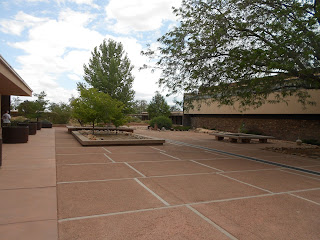 |
| Painted Desert |
The Painted Desert Inn
The Painted Desert Inn has a long history which dates back to the era of old Route 66. One of the very best views of the Painted Desert are found at this site. Kachina Point at the Painted Desert Inn offers a terrific view of the unique colorful landscape.
 |
| Painted Desert Visitor Center |
 |
| Painted Desert Inn |
The inn was constructed of wood and native stone in the Pueblo Revival style. Flagstone terraces outside the building overlook the desert. The building’s stone walls are more than two feet thick and finished with textured earth-toned stucco. Included were flat roofs with parapets and Ponderosa Pine logs are along the walls and ceiling. Two special features of the historic Painted Desert Inn are Fred Kabotie murals and a mountain lion petroglyph. This petroglyph was discovered in the 1930's and is considered one of the finest, animated and lifelike depictions of mountain lions in the region.
 |
| Interior look of Painted Desert Inn |
Many time when you talk about the southwest during the early to mid 1900's, the name Fred Harvey emerges. Some would say that the combination of the Atchison Topeka and Santa Fe Railroad were responsible for opening up America's southwest to tourism.
The Fred Harvey Company opened the inn in 1940. For two years, the inn offered Route 66 travelers food, souvenirs, and lodging that the Fred Harvey Company was famous for. Unfortunately, with the onset of World War Two the inn closed up in 1942. Much of this was simply due to the lack of resources which had been diverted to the war effort.
After the war in 1947, the Fred Harvey Company’s chief architect and interior designer, Mary Jane Colter, was given the task of renovating the facility. Mary Colter created a new interior color scheme and made other changes. Some of Colter's design changes included new plate glass windows to capitalize on the magnificent surrounding landscape. Any structure you build at the Painted Desert must have lots of windows. Also, as mentioned above, Colter arranged for Hopi artist Fred Kabotie to paint murals on the dining room and lunchroom walls that reflect Hopi culture. In addition to these fine renovations and historical touches, the popular Harvey Girls provided their legendary service at the inn. As was customary, the Harvey Girls served complete meals in the Painted Desert Inn dining room on spotless china. The Painted Desert Inn was designated as a National Historic landmark in 1987.
Links to additional Western Trips photo articles you'll enjoy are Arizona Route 66....La Posada in Winslow Arizona....Historic Downtown Flagstaff Arizona.
 |
| View from the Painted Desert Inn |
Recent Renovations
The most recent renovation of the Painted Desert Inn started in 2004 and as mentioned above was completed in 2006. This included new wiring, plumbing, structural upgrades including new flagstone on the terraces and more visitor conveniences.
Hiking the Painted Desert
The Painted Desert wilderness includes 43,020 acres of colorful mesas, buttes and badlands with scattered areas of grassland. One of the most popular hikes in the area is the Painted Desert Rim Trail which is a 1.2 mile roundtrip hike. This is considered an easy unpaved trail that goes along the Painted Desert rim between Tawa and Kachina Points.
Another very unique yet quite short hike is to the Puerco Indian Ruins and Petroglyphs. This is a half mile loop trail. The trail takes you to the ruins of a 76 room Anasazi pueblo. Some parts of the pueblo have been excavated. The trail begins at the Puerco Pueblo parking lot on the Petrified Forest Loop Road at mile marker 11. The mile marker is measured from the north entrance to the park off Interstate 40. A short paved trail leads from the parking lot to the ruins and petroglyphs.
These are only two of the several trails featured at the Painted Desert and Petrified Forest National Park.
The National Park Service also offers a series of off-trail guided hikes on Sundays in January, February, and March.
Getting There
The Painted Desert is a part of the Petrified Forest National Park. The north entrance to the park is directly off Interstate 40 about 20 miles east of Holbrook Arizona and fifty miles west of the New Mexico state line.
(Photos from author's private collection)

